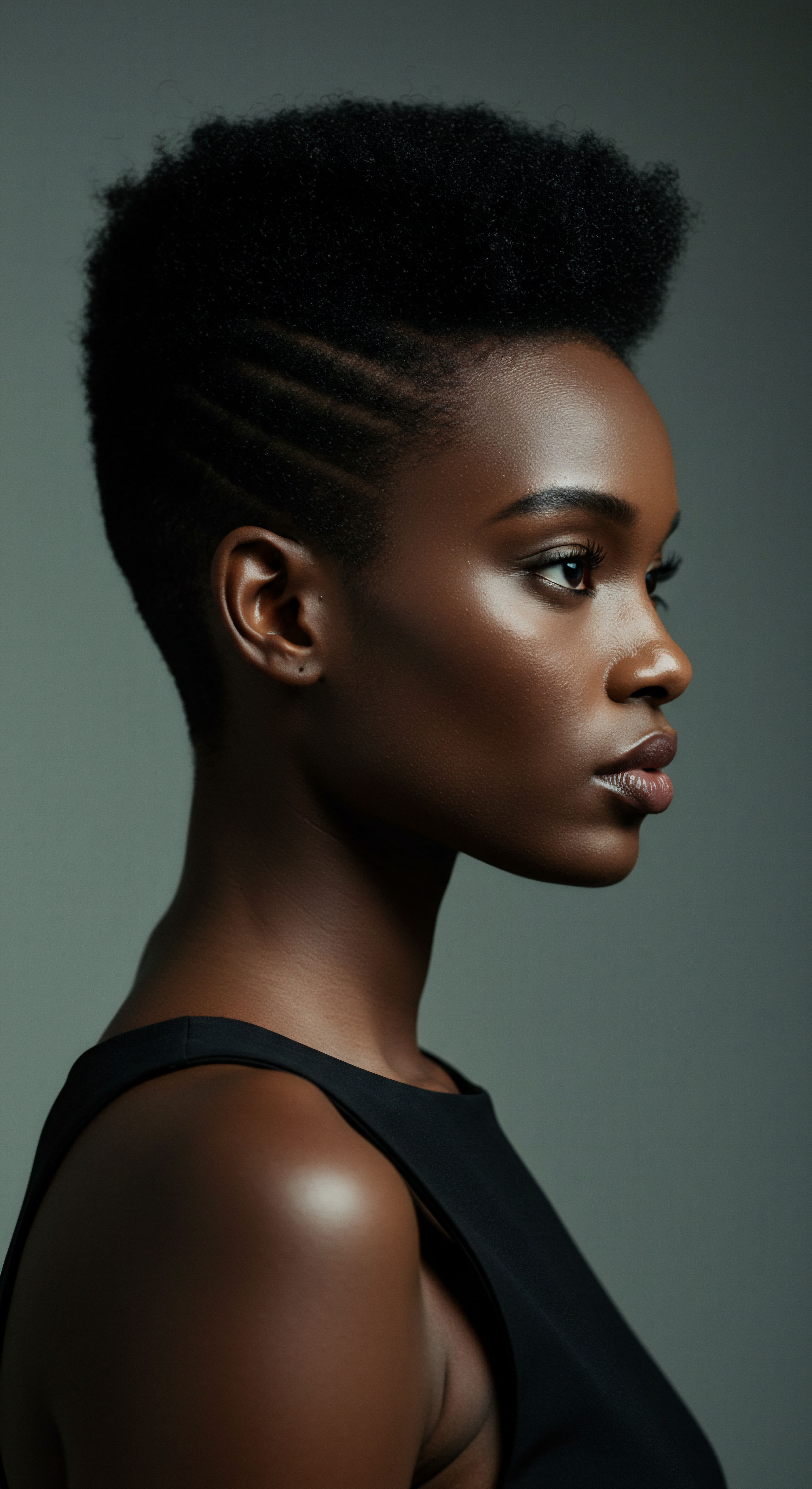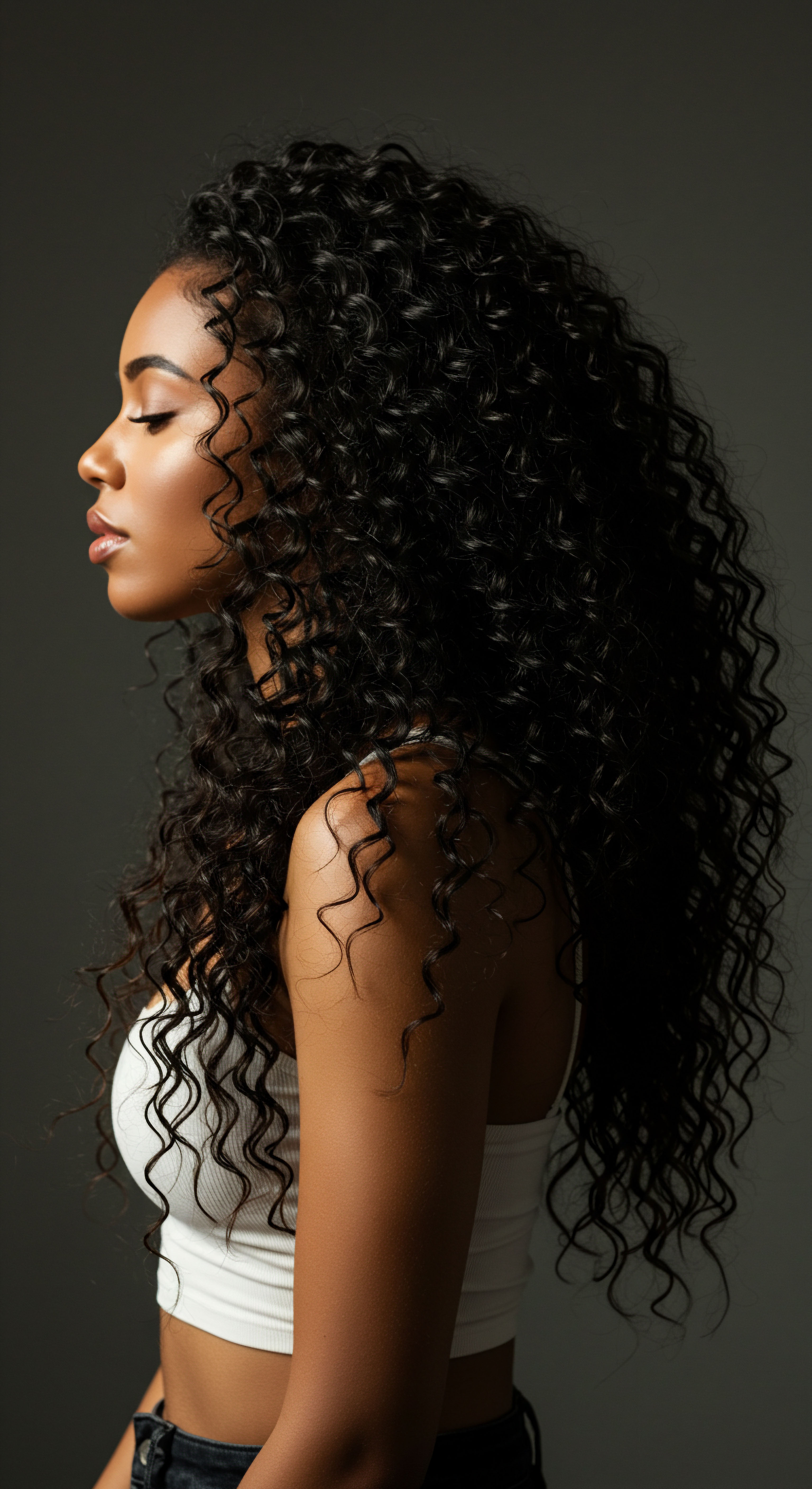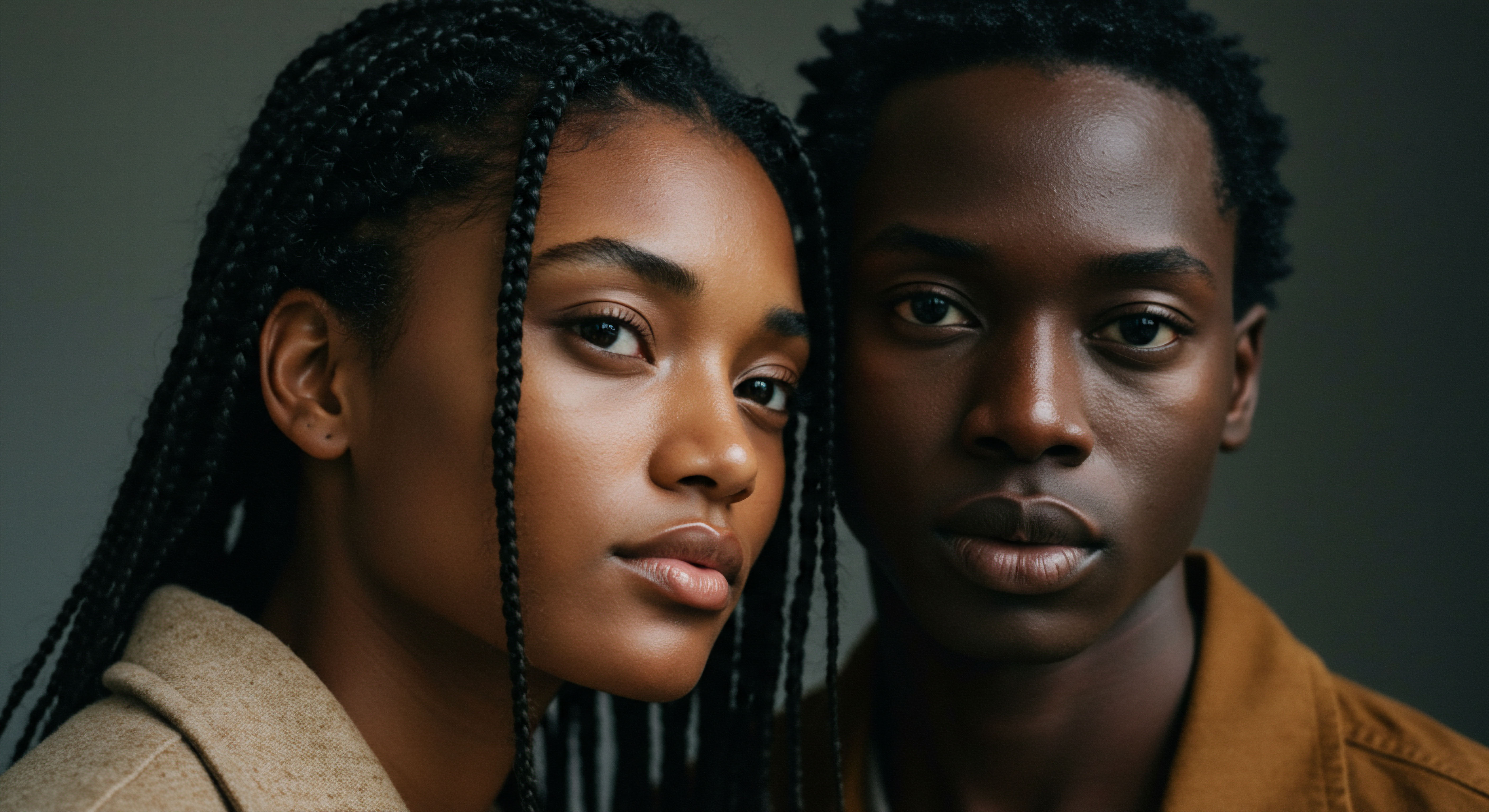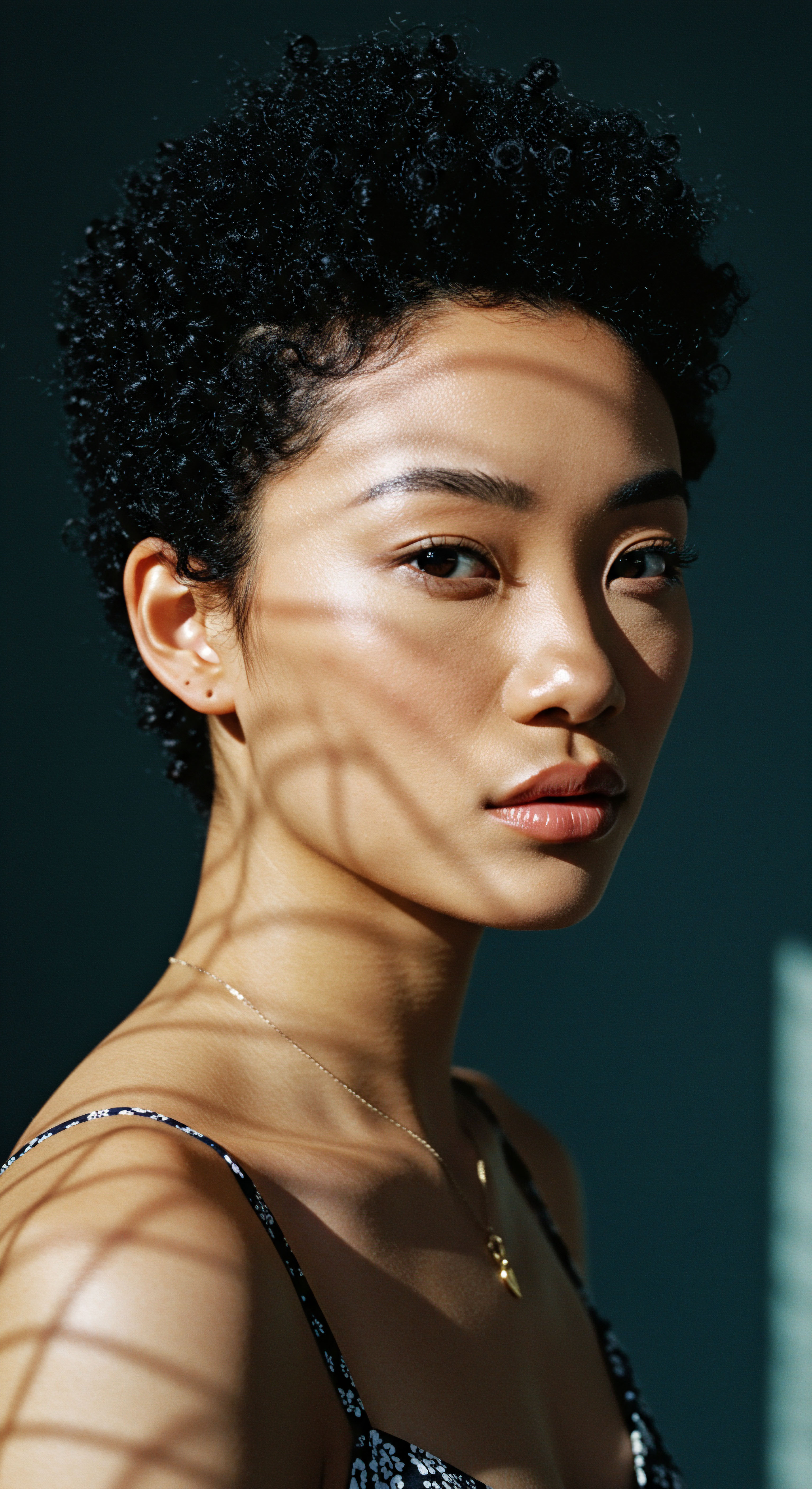
Roots
Imagine the gentle quiet of evening settling, a time when the world slows its spin and the very air softens. For those of us with textured hair, this twilight descent holds a particular weight, a quiet concern for the strands that crown our heads. We often find ourselves contemplating the unseen forces at play while we sleep, the subtle friction, the thirsty air, and how these elements conspire against the delicate structure of our curls and coils. It is within this nightly rhythm, this tender consideration for our hair’s wellbeing, that the wisdom of the silk bonnet truly shines, a practice rooted in both scientific understanding and generations of care.
The journey into understanding how silk bonnets assist textured hair begins with a look at the hair itself. Each strand, a marvel of biological engineering, possesses an outer layer known as the Cuticle. This cuticle comprises overlapping scales, much like the shingles on a roof, all working to shield the inner cortex.
In textured hair, these cuticle scales naturally tend to be more lifted or open due to the hair’s unique elliptical shape and curl pattern. This inherent characteristic, while contributing to the hair’s magnificent volume and bounce, also renders it more susceptible to moisture loss and physical damage.

What Makes Textured Hair Unique
Textured hair, encompassing a vast spectrum of curl patterns from loose waves to tight coils, carries a distinct architecture. Its coiled structure means that the natural oils, known as sebum, produced by the scalp, struggle to travel down the entire length of the hair shaft. This leads to a predisposition for dryness, particularly at the ends. Moreover, the points where the hair bends and twists along its helical path are areas of inherent weakness, more prone to breakage under stress.
- Hair Shape ❉ Unlike straight hair, which often presents a round cross-section, textured hair strands typically possess an elliptical or flattened shape. This shape contributes directly to the hair’s ability to form curls and coils.
- Cuticle Arrangement ❉ The outer cuticle layer of textured hair tends to have more lifted scales compared to straighter hair types. This lifting creates more surface area, which can lead to increased friction and moisture evaporation.
- Sebum Distribution ❉ The natural curvature of textured hair hinders the smooth descent of sebum from the scalp to the ends, often resulting in drier lengths and tips.

Understanding Hair’s Vulnerability at Night
As we drift into slumber, our hair, seemingly at rest, encounters an environment that can subtly, yet significantly, compromise its integrity. The very act of moving, shifting, and turning on a pillow creates mechanical stress. Traditional pillowcases, often made of cotton, possess a fibrous surface. This surface, under the repeated pressure and movement of a sleeping head, acts like a mild abrasive, tugging and snagging at the hair’s delicate cuticle.
Nighttime friction against common fabrics can subtly compromise the hair’s outer layer, leading to dryness and breakage.
This constant rubbing can cause the cuticle scales to lift further, leading to a cascade of undesirable outcomes. When these scales are raised, the hair’s internal moisture escapes more readily, resulting in dryness and a dull appearance. Furthermore, the friction can lead to tangles, knots, and ultimately, breakage, particularly for hair that is already predisposed to fragility. The environmental air itself, especially in dry climates or heated rooms, can also draw moisture from uncovered hair, exacerbating the dryness.
The concept of protecting hair during sleep is not a novel one; it echoes through generations and across cultures. From ancestral practices of wrapping hair in soft cloths to the modern adoption of silk bonnets, the underlying wisdom remains constant ❉ safeguard the hair from the elements of the night.

Ritual
With the foundational understanding of textured hair’s inherent nature and its nocturnal vulnerabilities, we turn our attention to the ritual of protection, a practice that elevates the simple act of sleeping into a profound gesture of care. The silk bonnet, far from being a mere accessory, becomes a guardian, a silent partner in the preservation of hair health. Its effectiveness lies in a beautiful synergy of material science and gentle application, transforming the nightly experience for textured strands.

How Does Silk Fabric Protect Hair?
The magic of silk rests in its inherent properties. Unlike cotton, which has a relatively rough, absorbent surface, silk fibers are remarkably smooth and possess a low coefficient of friction. This translates to a surface where hair glides effortlessly, rather than snagging and pulling.
This reduction in friction is perhaps the most celebrated benefit of silk bonnets. A study published in the Journal of Cosmetic Dermatology confirms that smoother fabrics, such as silk, assist in preventing hair shaft damage caused by repeated friction.
Consider the difference in how a delicate garment would fare if dragged across sandpaper versus a polished wooden surface. Our hair, especially when damp from evening moisture or natural oils, behaves similarly. Cotton’s absorbent nature also means it draws moisture away from the hair, potentially leading to dryness and frizz.
Silk, a protein-based fiber, is far less absorbent, allowing the hair to retain its natural hydration and any conditioning products applied before bed. This is particularly beneficial for textured hair, which, as discussed, is prone to dryness.
| Property Surface Texture |
| Silk Smooth, slippery |
| Cotton Fibrous, rough |
| Property Friction Coefficient |
| Silk Low (0.1-0.15) |
| Cotton Higher (approx. 0.3) |
| Property Moisture Absorption |
| Silk Low, retains hair's natural oils |
| Cotton High, absorbs hair's natural oils |
| Property Effect on Hair Cuticle |
| Silk Minimizes lifting and damage |
| Cotton Causes lifting and damage |
| Property Silk's inherent smoothness and low absorbency offer superior hair protection compared to cotton. |

Preserving Moisture and Hair’s Structure
The integrity of textured hair relies heavily on its moisture content. When the hair is dry, its elasticity diminishes, making it more brittle and susceptible to breakage. Silk bonnets create a gentle, enclosed environment around the hair, helping to seal in moisture and prevent its evaporation into the surrounding air. This microclimate fosters a more hydrated state for the hair, leading to less frizz and improved softness upon waking.
Silk bonnets cultivate a protective microclimate around the hair, safeguarding its moisture and structural integrity through the night.
Furthermore, the smooth surface of the bonnet allows curls and coils to maintain their defined shape without being flattened or distorted by friction. This means less need for extensive restyling in the morning, reducing manipulation and further minimizing potential damage. For those who meticulously define their curls or execute protective styles like twists or braids, a silk bonnet helps preserve the style, extending its life and reducing the frequency of styling sessions.

Beyond the Physical ❉ A Gentle Touch
The tactile experience of silk is also a significant, if often understated, benefit. The gentle caress of silk against the hair and scalp offers a sense of comfort and luxury, transforming a simple bedtime step into a soothing ritual. This gentle interaction is especially important for delicate strands, where every point of contact holds the potential for either harm or nurture. The lightweight nature of silk also means it does not add undue pressure or tension to the hair roots, ensuring comfortable wear throughout the night.

Relay
Moving beyond the immediate physical advantages, the discussion around silk bonnets for textured hair extends into a more profound discourse, touching upon the intersection of historical practices, material science, and the subtle yet persistent influence of our environment on hair health. How does the seemingly simple act of donning a silk bonnet at night echo a deeper understanding of hair’s biological vulnerability and its cultural significance? This query invites us to consider the long-term biological ramifications of friction, the cultural continuity of hair protection, and the intricate ways in which our choices shape our hair’s destiny.

The Cumulative Impact of Friction on Hair Health
While a single night of friction against a rough pillowcase might seem insignificant, the cumulative effect over months and years can be considerable. Hair, composed primarily of keratin proteins, suffers gradual wear and tear from mechanical stress. The outermost cuticle, a shield of overlapping cells, is the first line of defense.
When these scales are repeatedly lifted and abraded, the hair becomes more porous, losing internal moisture and making it susceptible to further damage. This degradation can lead to a noticeable decline in hair quality, manifesting as increased frizz, dullness, and breakage.
A study examining the impact of mechanical stress on hair found that repeated friction contributes to changes in the hair shaft, affecting its integrity. Consider the analogy of a well-traveled path; over time, even the most resilient surface shows signs of erosion. Similarly, the constant rubbing of hair against a cotton pillowcase during an average of 40 head movements per night can lead to a significant amount of cumulative damage. This is particularly relevant for textured hair, where the natural twists and turns of the strand present more opportunities for friction points and subsequent damage.
Moreover, friction can also contribute to static electricity buildup, which further exacerbates frizz and can cause hair strands to repel each other, making detangling more difficult and leading to additional breakage. Silk, with its smooth surface, minimizes this static charge, allowing hair to remain cohesive and less prone to tangling.

The Deeper Meaning of Hair Protection in Cultural Contexts
The practice of covering hair, particularly at night, carries a rich historical and cultural lineage, especially within communities with textured hair. Headwraps and various forms of hair coverings have been integral to African and African diaspora cultures for centuries, serving purposes beyond mere adornment. Initially, these coverings provided practical protection from the sun and elements, especially for women engaged in farming and daily labor. Over time, they acquired deeper social, spiritual, and symbolic meanings, communicating marital status, age, and social standing.
During periods of enslavement, head coverings, sometimes enforced by oppressive laws like the Tignon Laws in Louisiana, became symbols of resistance and resilience. Black women transformed these mandates into statements of dignity and pride, reclaiming the coverings as expressions of cultural identity and self-respect. This historical context provides a profound backdrop to the modern use of silk bonnets.
It is not simply a contemporary beauty hack; it is a continuation of an ancestral wisdom, a quiet act of self-preservation and cultural affirmation. The silk bonnet, in this light, becomes a modern iteration of a protective tradition, connecting contemporary hair care to a lineage of care and resilience.
The contemporary use of silk bonnets aligns with historical practices of hair protection, echoing a long-standing tradition of care and cultural identity.
The selection of silk, a material revered for its smooth texture and minimal absorbency, represents an evolution in this protective practice, optimizing the benefits for hair health while honoring the spirit of preservation. The awareness of these historical layers adds a profound depth to the simple act of covering one’s hair at night.

Beyond Surface Level ❉ Hair Follicle Health and Sleep
The benefits of protecting hair at night extend beyond merely preserving the existing strands. The sleep environment can also influence the health of the hair follicle itself, the living part of the hair that resides beneath the scalp. During sleep, the body undergoes essential repair and regeneration processes. This includes the production of growth hormones and the repair of cells, which are vital for healthy hair growth.
Chronic sleep deprivation can disrupt these physiological processes, potentially leading to imbalances that affect the hair growth cycle. Elevated stress hormones, such as cortisol, linked to insufficient sleep, can trigger temporary hair shedding. While a silk bonnet does not directly alter hormonal balance, it contributes to an overall environment of hair care that supports healthy growth by minimizing external stressors.
By reducing friction and preventing tangles, it reduces the mechanical stress on the hair shaft, which in turn reduces tension on the hair follicles. This gentle treatment can contribute to a more undisturbed environment for the follicles to function optimally, promoting healthier growth over time.
Consider the finding that “under friction, hair treated with SDS solution loses seven times more protein than in water.” While this study focused on chemical interaction, it underscores the susceptibility of hair proteins to mechanical forces. By minimizing friction, silk bonnets indirectly contribute to maintaining the protein integrity of the hair, supporting its strength and overall health from root to tip.

Reflection
As the sun dips below the horizon and the world prepares for rest, the silk bonnet emerges not merely as a nightly accessory, but as a quiet testament to a deeper understanding of textured hair. It is a tangible link between ancestral wisdom and contemporary science, a gentle guardian against the unseen rigors of the night. Beyond the smooth touch and the preserved curls, it represents a conscious choice to honor the unique qualities of our hair, to offer it the care it deserves, and to greet each morning with strands that feel refreshed, resilient, and ready for the day’s light. This simple ritual, imbued with history and informed by knowledge, allows our hair to truly flourish, a quiet celebration of its inherent beauty.

References
- “Silk Pillowcase Benefits for Hair Extensions Users.” Digital Library Hub.
- “HEADWRAPS ❉ HISTORY AND EVOLUTION.” JD Institute of Fashion Technology.
- “Significance of headwraps | Hair care.” Obé Headwear.
- “The History and Symbolism of Hair Wrapping Across the African Diaspora.” Ari Party Hair.
- “Head Wrap History – From South Africa to Global Fashion.” Jelani Travel.
- “Discover how silk pillowcases transform your sleep, skin, and hair.” Silk Works.
- “Understanding the Hair Cuticle ❉ A Stylist’s Guide.” SALONORY Studio.
- “Beauty Sleep 2.0 ❉ The Science Behind Silk Pillowcases and Their Impact on Skin Health.” (2023-09-29)
- “News – Why Head Wraps Matter in Culture and Fashion.” (2025-05-10)
- “Silk vs. Cotton Pillowcases for Hair Extensions.” purehairexperience.
- “Silk Vs. Cotton ❉ Understanding the Key differences for Skin and Moisture Management.” Mulberry Park Silks.
- “Damaged Hair Cuticle ❉ How to Spot, Treat, and Repair It for Healthier Hair.” Laifen-EU.
- “Historical Perspectives on Hair Care and Common Styling Practices in Black Women.” MDEdge.
- “Damaged Hair Cuticles – What It Is, Causes, Treatment & Prevention.” Organic Harvest Blog.
- “Silk vs. Cotton ❉ In-Depth Analysis from Fabric Experts.” (2025-05-15)
- “Silk Vs. Cotton. Which is better for my hair?” (2023-04-12)
- “FRICTION COEFFICIENT AND ELECTRIC STATIC CHARGE OF HEAD SCARF TEXTILES.” EKB Journal Management System.
- “Benefits for Skin and Hair – Why Silk Pillowcases Are the Best Option.” 6FIFTYTWO®.
- “Is 100% Cotton Good for Hair? Trichologist Opinion.” Ayesha’s Collection.
- “Is Silk or Satin Better for Hair? TikTok’s Viral Hack vs. Science.” Blissy.
- “Slipssy’s First-Night Effect ❉ How Reducing Friction Transforms Your Hair Overnight.” (2025-04-16)
- “How to repair damaged hair ❉ Methods and how they work.” Medical News Today.
- “How to Repair Damaged Hair ❉ Common Causes and Treatments.” Healthline.
- “Caring for Afro-textured hair.” British Association of Dermatologists.
- “Contemporary African-American Hair Care Practices.” (2015-05-02)
- “(PDF) Effect of Hairiness on Fabric Colour Characteristics.” ResearchGate.
- “Silk Sleepwear vs. Cotton Sleepwear.” Elle Silk.
- “Afro-Beauty-Hair-Care-Booklet.pdf.” Dane County Department of Human Services.
- “Historical Hair Care Grew My Hair to Hip Length! Here’s How.” Katherine Haircare.
- “What are the benefits of using cotton or silk bed sheets and pillowcases on your skin and hair?” Quora.
- “The Long-Term Effects of Slipssy ❉ Protecting Your Hair Follicles, Pres.” (2025-04-16)
- “How Sleep Is Affecting Your Hair?” (2025-04-29)
- “Analysis on tensile properties of human hair fiber.” ResearchGate.
- “Is It Bad to Sleep with Wet Hair? | University of Utah Health.” (2023-09-12)
- “Performance ofspeciality hair fibers blended wool fabrics.” JETIR.org.
- “Hair protein removal by sodium dodecyl sulfate.” PubMed.
- “Sleep and Hair Growth ❉ How Your Nighttime Hair Care Routine Impacts Your Hair.” (2025-03-11)
- “Effect of Fiber Loading and Void Content on Tensile Properties of Keratin Based Randomly Oriented Human Hair Fiber Composites.” Scientific & Academic Publishing.
- “Silk vs Cotton Pillowcases ❉ Which Is Best for Your Hair?” Lordhair.com.
- “Impact of Sleep Deprivation on Hair Health.” Clinikally.
- “Full article ❉ Fabrication and Characterization of Eco-Friendly Natural Human Hair Fiber Reinforced Polyester Composite.” Taylor & Francis Online.
- “Types and characteristics of hair across different countries ❉ results.” CCID.
- “ANALYSIS AND QUANTIFICATION OF HAIR DAMAGE ❉ PROGRESS REPORT NO. 32.”
- “(PDF) UV damage of the Hair.” ResearchGate.